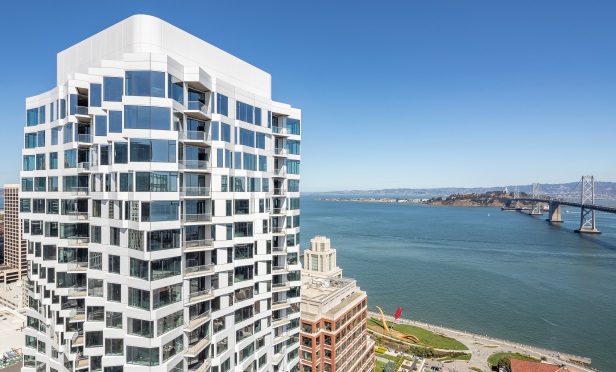 For the curtain wall, a modular facade system was created that repeats every 11 floors.
For the curtain wall, a modular facade system was created that repeats every 11 floors.
SAN FRANCISCO—Mira's curtain wall is now completed, punctuating the skyline with its twisted facade. The Tishman Speyer neighborhood of condominium residences began construction in mid-2017 and has progressed steadily since then, with occupancy of the 400-foot tower slated for early 2020. Sales of homes at Mira are currently underway.
"With the final piece of Mira's curtain wall in place, we're excited that the project can now assume its final form and add its remarkable architectural statement to the San Francisco skyline," says Carl Shannon, senior managing director at Tishman Speyer. "We are now one step closer to residents moving into this beautiful tower."
The architecture and interiors were designed by architect Jeanne Gang. To realize the geometric complexity of the project's white curtain wall, a modular facade system with groups of units repeating every 11 floors was created. The engineering process was adapted from the aerospace industry to achieve the flat and clean look of the curtain wall's Italian-made white panels. The curtain wall is a part of a spiraling design with large bay windows that twist up the building's facade.
"Reinterpreting the classic bay windows of San Francisco, our design amplifies the dynamic quality of the neighborhood," says Gang, founding principal of Studio Gang. "Spiraling all the way up this 400-foot tower, bay windows create unique spaces in every residence that offer fresh air, expansive views and changing qualities of light throughout the day."
Located in the emerging Transbay neighborhood where SoMa meets the Embarcadero, Mira will offer access to the waterfront, the new Salesforce Park and Transbay Transit Terminal, and a wide array of retailers, nightlife, restaurants, transportation options, and sports and entertainment venues. The community will contribute to the neighborhood created by Tishman Speyer's nearby Infinity and Lumina projects. The site was previously known as Block One of the Transbay Redevelopment Plan.
"Mira's bright white, twisting design adds a new and distinctive architectural statement to the San Francisco skyline," Shannon tells GlobeSt.com. "Jeanne Gang has reinterpreted the classic bay window in a manner that has never been done before and we are extremely proud of her achievement."
San Francisco's skyline now sports seven towers more than 350 feet built from the ground up by Tishman Speyer. This represents a continued commitment by the firm to develop property with distinguished architects. Since 2008, Infinity, Lumina, Mira, 555 Mission and 222 Second St. have risen, totaling five residential towers and two office high-rise buildings. Two more 400-foot residential towers have been approved for construction in central SoMa, as well as two residential towers and two office buildings in China Basin as a part of Mission Rock, an expansive collaboration with the San Francisco Giants that will include restaurants, shops, cafes and a 5-acre bayside park.
The projects have been designed by architects including Arquitectonica for Infinity and Lumina, Studio Gang for Mira and Mission Rock, WORKac, Henning Larson and MVRDV for Mission Rock, KPF for 555 Mission, and Pfeiffer Partners and Gensler for 222 Second St. A recently approved residential project known as The Creamery is being designed by Bjarke Ingels Group. When all residential projects are completed, Tishman Speyer will have contributed slightly less than 3,175 new market-rate homes and more than 1,000 affordable residences to San Francisco, a total of some 4,200 new homes.
As conditions remain tight, builders have expanded the scale and scope of projects underway, with seven offerings exceeding 500 units, according to a report by Marcus & Millichap. The vast majority of deliveries will be at locations in the urban core, says the report.
© Touchpoint Markets, All Rights Reserved. Request academic re-use from www.copyright.com. All other uses, submit a request to [email protected]. For more inforrmation visit Asset & Logo Licensing.







